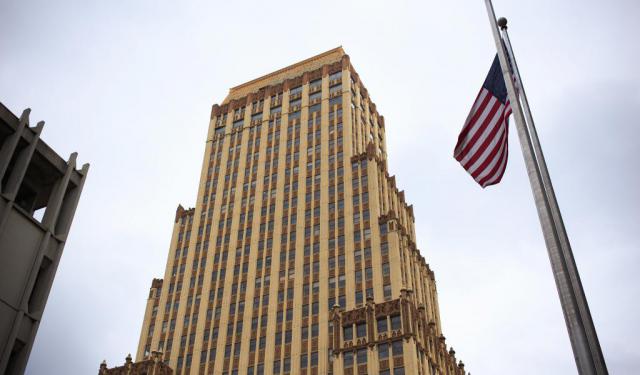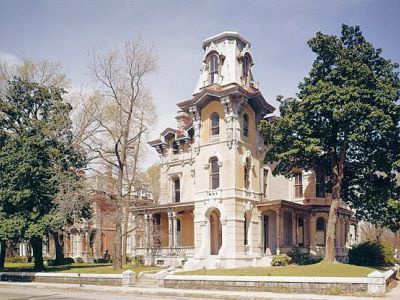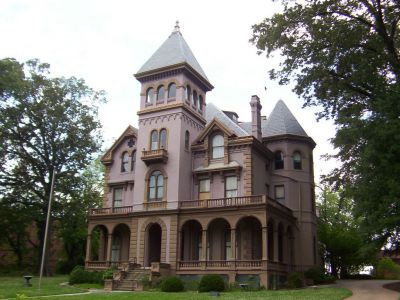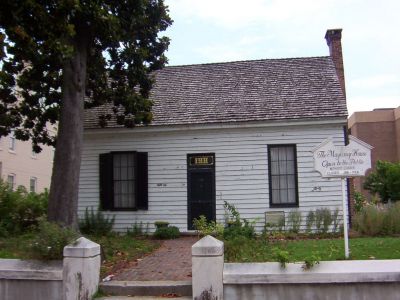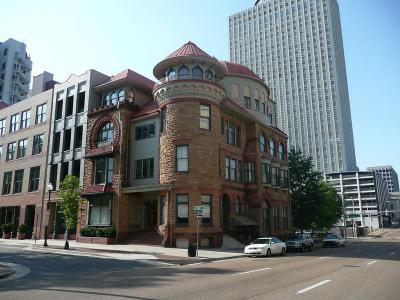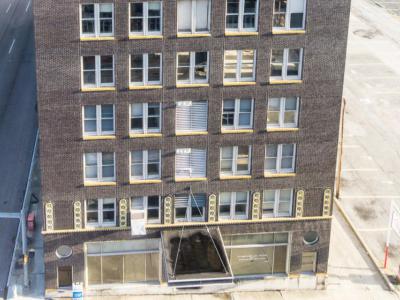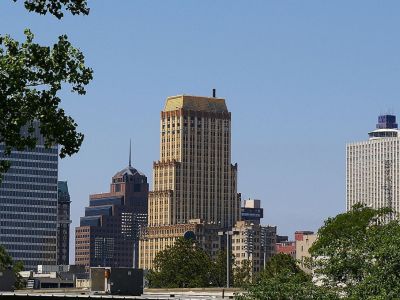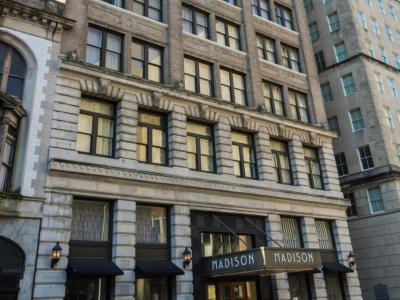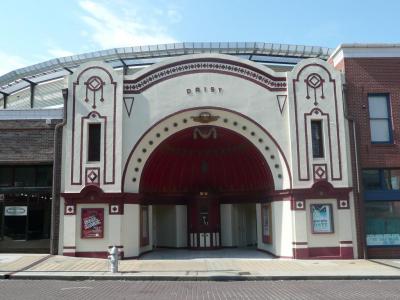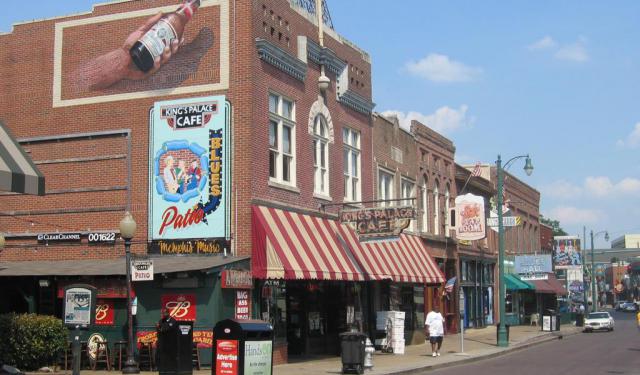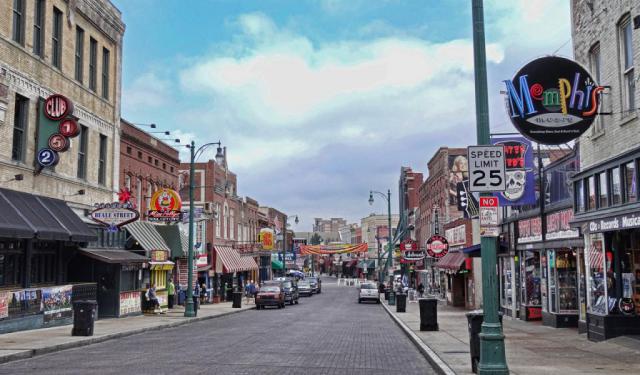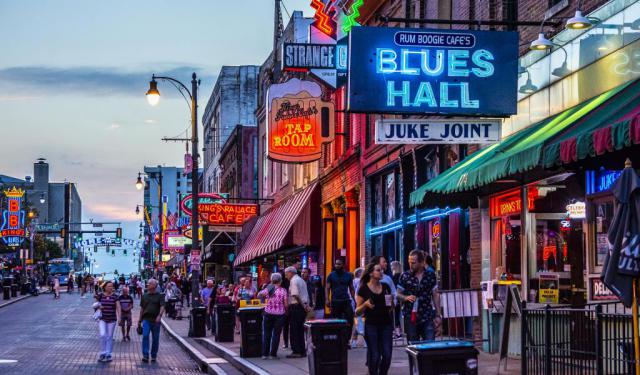Historical Buildings Walking Tour (Self Guided), Memphis
A substantial part of Memphis' heritage is manifested in its iconic buildings. By far more than just bricks and mortar, they are a history window through which one can observe the city's growth and development over the years. Here's a brief overview of some of these notable structures.
Harsson-Goyer-Lee House: This charming 19th-century mansion stands as a testament to Memphis' antebellum era, showcasing its grand architecture and cultural significance.
A stunning example of Victorian design, the Mallory-Neely House offers a glimpse into the opulent lifestyles of Memphis' elite from the late 19th to the mid-20th centuries.
The Magevney House is a simple yet historically significant structure, known for its association with the Irish immigrant community and early Memphis history.
Burch, Porter & Johnson's: This building holds historical significance as the former location of a prominent law firm, representing the legal heritage of Memphis.
A striking example of early 20th-century architecture, the Dermon Building stands as a symbol of the city's growth during that era.
The Sterick Building, with its Gothic Revival design, was once Memphis' tallest skyscraper and remains an iconic symbol of the city's skyline.
The historic Madison Hotel has been a gathering place for Memphians and visitors alike since 1905, offering a blend of modern luxury and historical charm.
Once a legendary music venue on Beale Street, the Old Daisy Theatre witnessed the birth of blues music and continues to preserve its musical heritage.
Exploring the above architectural landmarks and learning their stories, we ensure that Memphis' rich heritage continues to be celebrated and passed down to future generations. Our self-guided tour is to help you find your way around the asphalt jungle of Downtown Memphis and acquaint yourself more closely with its living history pieces that deserve appreciation.
Harsson-Goyer-Lee House: This charming 19th-century mansion stands as a testament to Memphis' antebellum era, showcasing its grand architecture and cultural significance.
A stunning example of Victorian design, the Mallory-Neely House offers a glimpse into the opulent lifestyles of Memphis' elite from the late 19th to the mid-20th centuries.
The Magevney House is a simple yet historically significant structure, known for its association with the Irish immigrant community and early Memphis history.
Burch, Porter & Johnson's: This building holds historical significance as the former location of a prominent law firm, representing the legal heritage of Memphis.
A striking example of early 20th-century architecture, the Dermon Building stands as a symbol of the city's growth during that era.
The Sterick Building, with its Gothic Revival design, was once Memphis' tallest skyscraper and remains an iconic symbol of the city's skyline.
The historic Madison Hotel has been a gathering place for Memphians and visitors alike since 1905, offering a blend of modern luxury and historical charm.
Once a legendary music venue on Beale Street, the Old Daisy Theatre witnessed the birth of blues music and continues to preserve its musical heritage.
Exploring the above architectural landmarks and learning their stories, we ensure that Memphis' rich heritage continues to be celebrated and passed down to future generations. Our self-guided tour is to help you find your way around the asphalt jungle of Downtown Memphis and acquaint yourself more closely with its living history pieces that deserve appreciation.
How it works: Download the app "GPSmyCity: Walks in 1K+ Cities" from Apple App Store or Google Play Store to your mobile phone or tablet. The app turns your mobile device into a personal tour guide and its built-in GPS navigation functions guide you from one tour stop to next. The app works offline, so no data plan is needed when traveling abroad.
Historical Buildings Walking Tour Map
Guide Name: Historical Buildings Walking Tour
Guide Location: USA » Memphis (See other walking tours in Memphis)
Guide Type: Self-guided Walking Tour (Sightseeing)
# of Attractions: 8
Tour Duration: 2 Hour(s)
Travel Distance: 3.1 Km or 1.9 Miles
Author: val
Sight(s) Featured in This Guide:
Guide Location: USA » Memphis (See other walking tours in Memphis)
Guide Type: Self-guided Walking Tour (Sightseeing)
# of Attractions: 8
Tour Duration: 2 Hour(s)
Travel Distance: 3.1 Km or 1.9 Miles
Author: val
Sight(s) Featured in This Guide:
- Harsson-Goyer-Lee House
- Mallory-Neely House
- Magevney House
- Burch, Porter & Johnson's Historic Location
- Dermon Building
- Sterick Building
- Madison Hotel
- Old Daisy Theatre
1) Harsson-Goyer-Lee House
The James Lee House, also referred to as the Harsson-Goyer-Lee House, is a historic residence located on Adams Avenue in Memphis. This property holds a place on the National Register of Historic Places, along with the neighboring Woodruff-Fontaine House, and both structures are part of the Victorian Village historic district.
Built in 1848, the house boasts an impressive 8,100 square feet of space and was originally constructed by William Harsson. In 1852, Charles Wesley Goyer, who was married to Harsson's daughter Laura, acquired the property. Goyer enlisted the services of the architectural firm of Edward Culliatt Jones and Matthias H. Baldwin in 1871 to expand the house, inspired by their work on the nearby Woodruff-Fontaine House.
In 1890, James Lee, a riverboat captain with a Princeton University education, became the new owner of the house. By 1925, it had transformed into the James Lee Memorial Art Academy, a precursor to the Memphis College of Art (formerly known as the Memphis Academy of Art). The city of Memphis took ownership in 1929, and after the art school relocated in 1959, the house remained vacant for an extended period. Interestingly, it gained some pop culture recognition when Canadian indie rock group Tokyo Police Club used it as a backdrop for their 2008 music video "In a Cave."
In 2012, the vacant house found new private owners, and the following year marked the beginning of a substantial construction and renovation project. This transformation converted the house into a luxurious bed and breakfast. The city of Memphis supported the renovation effort by providing a property tax abatement to encourage the restoration.
Consequently, in April 2014, the bed and breakfast officially opened its doors for business. Today, visitors to Memphis have the opportunity to experience the charm of The James Lee House by staying as guests in this splendid historic establishment.
Built in 1848, the house boasts an impressive 8,100 square feet of space and was originally constructed by William Harsson. In 1852, Charles Wesley Goyer, who was married to Harsson's daughter Laura, acquired the property. Goyer enlisted the services of the architectural firm of Edward Culliatt Jones and Matthias H. Baldwin in 1871 to expand the house, inspired by their work on the nearby Woodruff-Fontaine House.
In 1890, James Lee, a riverboat captain with a Princeton University education, became the new owner of the house. By 1925, it had transformed into the James Lee Memorial Art Academy, a precursor to the Memphis College of Art (formerly known as the Memphis Academy of Art). The city of Memphis took ownership in 1929, and after the art school relocated in 1959, the house remained vacant for an extended period. Interestingly, it gained some pop culture recognition when Canadian indie rock group Tokyo Police Club used it as a backdrop for their 2008 music video "In a Cave."
In 2012, the vacant house found new private owners, and the following year marked the beginning of a substantial construction and renovation project. This transformation converted the house into a luxurious bed and breakfast. The city of Memphis supported the renovation effort by providing a property tax abatement to encourage the restoration.
Consequently, in April 2014, the bed and breakfast officially opened its doors for business. Today, visitors to Memphis have the opportunity to experience the charm of The James Lee House by staying as guests in this splendid historic establishment.
2) Mallory-Neely House
The Mallory-Neely House is a historic mansion located on Adams Avenue in the renowned Victorian Village district of Memphis. The residence was built in 1852 for banker Isaac Kirtland and his family. The house name comes from two of the families that lived there, the Barton Lee Mallory and James Columbus Neely families. The home features an Italianate villa-style design, turn of the century furnishings and decor, stained glass windows, artwork, and statutes from the around the world.
From 1852 to 1969, several prominent families lived in the home. The last person to live in the house was Daisy Neely Mallory. The dwelling was deeded to the Daughters, Sons, and Children of the American Revolution upon Mrs. Mallory’s death. The home became part of the National Register of Historic Places in 1972 and was turned into a museum in 1973.
The Mallory-Neely House is now a museum managed by the Memphis Park Commission and Memphis Museums, Inc. have managed the house since 1987.
From 1852 to 1969, several prominent families lived in the home. The last person to live in the house was Daisy Neely Mallory. The dwelling was deeded to the Daughters, Sons, and Children of the American Revolution upon Mrs. Mallory’s death. The home became part of the National Register of Historic Places in 1972 and was turned into a museum in 1973.
The Mallory-Neely House is now a museum managed by the Memphis Park Commission and Memphis Museums, Inc. have managed the house since 1987.
3) Magevney House
Located on Adams Avenue in the Victorian Village is the Magevney House, one of the oldest residences in the city. The house was built in the 1830s by Eugene Magevney, an Irish immigrant, and includes an herb garden and grape arbor. Magevney emigrated from Ireland to the United States in 1828 and settled in Memphis in 1833. He worked as an educator and civic leader until his death from yellow fever in 1873. The house contains many personal effects of the family and gives an accurate glimpse into their lives.
The clapboard house is an important part of Catholic history in Memphis. It is the site of the first Catholic marriage, the first Catholic baptism, and the first Catholic mass. Magevney also helped to found the first Catholic Church in Memphis. The house was donated to the city of Memphis by the family of Eugene Magevney in 1941 and became part of the National Register of Historic Places in 1973.
The clapboard house is an important part of Catholic history in Memphis. It is the site of the first Catholic marriage, the first Catholic baptism, and the first Catholic mass. Magevney also helped to found the first Catholic Church in Memphis. The house was donated to the city of Memphis by the family of Eugene Magevney in 1941 and became part of the National Register of Historic Places in 1973.
4) Burch, Porter & Johnson's Historic Location
One important landmark in Memphis is the Burch, Porter & Johnson's Law Firm. Located on Court Avenue, the building has played a significant part in Memphis history. The firm is composed of two buildings, the Tennessee Club Building and the Goodbar Building. Construction joined the two together in 1982.
The firm represented Dr. Martin Luther King during the Memphis Sanitation March in 1968, and was in court representing him when they heard of the assassination attempt that took his life.
The Tennessee Club Building was erected in 1890 by Edward Terrell, and functioned as an art gallery, library and social club. Carrie Nation gave a speech on the club’s front stairs and William H. Taft and Teddy Roosevelt visited the building. It has been listed on the National Register of Historic Places since April 22, 1982.
The firm represented Dr. Martin Luther King during the Memphis Sanitation March in 1968, and was in court representing him when they heard of the assassination attempt that took his life.
The Tennessee Club Building was erected in 1890 by Edward Terrell, and functioned as an art gallery, library and social club. Carrie Nation gave a speech on the club’s front stairs and William H. Taft and Teddy Roosevelt visited the building. It has been listed on the National Register of Historic Places since April 22, 1982.
5) Dermon Building
The Dermon Building is an impressive 10-story 10,000 square foot building in downtown Memphis. Located at the junction of Court Avenue and North Third Street, the building is famous for its dark brown brick and yellow, green, and white terra cotta exterior. Although many buildings featured terra cotta design, most terra cotta buildings in the 1920s were white in color. The multi-colored design of this building makes it a remarkable contribution to the Memphis skyline.
The building was constructed in 1925 by architects Charles Pfiel and George Awsum, designers of the Tennessee Trust Building, the Fire Engine House #1, and the Memphis Police Station. The building housed the Dave Dermon Company, a real estate company, and Dave Dermon Insurance until 1983. In addition to the beautiful terra cotta design, the building is an important part of Memphis history because of its contribution to the real estate development of the city.
Dave Dermon played an important part in the development of downtown and mid-town Memphis between World War I and the Depression through his realty company. He constructed apartment complexes, auto dealerships, and subdivisions. Because of this contribution to the city, the building became a part of the National Historic Places in 1984. The upper floors of the building offer spectacular views of downtown Memphis.
The building was constructed in 1925 by architects Charles Pfiel and George Awsum, designers of the Tennessee Trust Building, the Fire Engine House #1, and the Memphis Police Station. The building housed the Dave Dermon Company, a real estate company, and Dave Dermon Insurance until 1983. In addition to the beautiful terra cotta design, the building is an important part of Memphis history because of its contribution to the real estate development of the city.
Dave Dermon played an important part in the development of downtown and mid-town Memphis between World War I and the Depression through his realty company. He constructed apartment complexes, auto dealerships, and subdivisions. Because of this contribution to the city, the building became a part of the National Historic Places in 1984. The upper floors of the building offer spectacular views of downtown Memphis.
6) Sterick Building
The Sterick Building is the fifth tallest building and was the tallest building in Tennessee until the early 1960s. Featuring a Gothic Revival style, this 29-story building was designed by Wyatt C. Hendrick and Company. It was named for its first owners, R.E. Sterling and Wyatt Hedrick. The building was constructed in 1930.
Located on the corner of Madison Avenue and North Third Street, this building was known as “The Queen of Memphis” and “the most complex, most fabulous building in Memphis.” Some of the businesses this rare jewel contained included a pharmacy, beauty parlor, bank, barber shop, stockbrokers’ offices, and a Regency Room restaurant.
The building began to lose its luster during the 1960s and has been vacant since the 1980s. Although the Memphis Center City Commission placed the Sterick Building on its list of "Top Ten Center City Redevelopment Sites in 2006, there are no plans to renovate or reopen the building.
The Sterick Building was placed on the National Register of Historic Places in 1978.
Located on the corner of Madison Avenue and North Third Street, this building was known as “The Queen of Memphis” and “the most complex, most fabulous building in Memphis.” Some of the businesses this rare jewel contained included a pharmacy, beauty parlor, bank, barber shop, stockbrokers’ offices, and a Regency Room restaurant.
The building began to lose its luster during the 1960s and has been vacant since the 1980s. Although the Memphis Center City Commission placed the Sterick Building on its list of "Top Ten Center City Redevelopment Sites in 2006, there are no plans to renovate or reopen the building.
The Sterick Building was placed on the National Register of Historic Places in 1978.
7) Madison Hotel
The Madison Hotel is a luxury boutique hotel in the heart of Downtown Memphis. What sets this hotel apart is its fascinating history, as it occupies a building that originally served as the Tennessee Trust Bank, constructed in the year 1905. This 14-story structure marked one of Downtown Memphis's first skyscrapers, representing a combination of historical significance and contemporary luxury.
Designed by the architectural firm of Charles O. Pfeil and George M. Shaw, known for their intricate and classical designs, the building stands as a testament to early 20th-century architectural style. It boasts distinctive design elements like a scroll pattern on its western facade, a characteristic it shares with other buildings in the area designed by Shaw & Pfeil. The building's historical charm includes a converted bank vault turned hotel gym. Recognizing its architectural and historical significance, the building earned a place on the National Register of Historic Places in 1982.
The Madison Hotel represents sophistication and modern conveniences, positioning itself as a top selection in the heart of the city's business hub. The rooms are beautifully designed, showcasing a blend of stylish wall decorations and lively color schemes. Several rooms provide stunning views of the river, particularly those located on the upper floors facing the west.
One of the hotel's standout features is the Twilight Sky Terrace. Here, guests can enjoy drinks and small plates while taking in the picturesque Memphis skyline. For dining options, the hotel's restaurant now offers outdoor patio seating on Main Street, perfect for a quick meal or a drink before exploring Memphis's vibrant music scene.
Designed by the architectural firm of Charles O. Pfeil and George M. Shaw, known for their intricate and classical designs, the building stands as a testament to early 20th-century architectural style. It boasts distinctive design elements like a scroll pattern on its western facade, a characteristic it shares with other buildings in the area designed by Shaw & Pfeil. The building's historical charm includes a converted bank vault turned hotel gym. Recognizing its architectural and historical significance, the building earned a place on the National Register of Historic Places in 1982.
The Madison Hotel represents sophistication and modern conveniences, positioning itself as a top selection in the heart of the city's business hub. The rooms are beautifully designed, showcasing a blend of stylish wall decorations and lively color schemes. Several rooms provide stunning views of the river, particularly those located on the upper floors facing the west.
One of the hotel's standout features is the Twilight Sky Terrace. Here, guests can enjoy drinks and small plates while taking in the picturesque Memphis skyline. For dining options, the hotel's restaurant now offers outdoor patio seating on Main Street, perfect for a quick meal or a drink before exploring Memphis's vibrant music scene.
8) Old Daisy Theatre
Located on the famous Beale Street, the Old Daisy Theater is known as the “#1 tourist attraction in the State of Tennessee". Built in 1902, the venue was a major stop on the “Chitlin’ Circuit” from the 1930s to the 1960s. The “Chitlin’ Circuit” was the only safe way for Rhythm and Blues artists to perform in the segregated South. George Benson, Ike and Tina Turner, Duke Ellington, the Jackson Five, Lena Horne, the Temptations, Aretha Franklin, and Wilson Pickett are just a few of the many musical artists who toured the South in this manner.
The theater reflects a Nickelodeon-Style design and features a horse-shaped balcony that is supported with iron rods, and a stage and screen located on the sidewalk. In the 1980s, the building was converted into a Blues Museum.
A new Daisy Theater was built across the street in the 1930s featuring live entertainment from established and up-and-coming artists, such as John Lee Hooker, Al Green, Sam and Dave, Bob Dylan, Alice in Chains, Justin Timberlake, Nelly, and the Cult.
Currently, the Old Daisy Theater serves as a banquet hall for meetings, events, and banquets. Catering services are available.
The theater reflects a Nickelodeon-Style design and features a horse-shaped balcony that is supported with iron rods, and a stage and screen located on the sidewalk. In the 1980s, the building was converted into a Blues Museum.
A new Daisy Theater was built across the street in the 1930s featuring live entertainment from established and up-and-coming artists, such as John Lee Hooker, Al Green, Sam and Dave, Bob Dylan, Alice in Chains, Justin Timberlake, Nelly, and the Cult.
Currently, the Old Daisy Theater serves as a banquet hall for meetings, events, and banquets. Catering services are available.
Walking Tours in Memphis, Tennessee
Create Your Own Walk in Memphis
Creating your own self-guided walk in Memphis is easy and fun. Choose the city attractions that you want to see and a walk route map will be created just for you. You can even set your hotel as the start point of the walk.
Memphis Downtown Walking Tour
Downtown is the oldest part of Memphis. This vibrant and culturally rich district is home to a variety of historical, artistic, and entertainment destinations that collectively reflect the unique heritage and spirit of the “blues city”.
One of the area's standout attractions is the Fire House Museum, a fascinating spot where visitors can explore the history of the city's fire... view more
Tour Duration: 2 Hour(s)
Travel Distance: 3.1 Km or 1.9 Miles
One of the area's standout attractions is the Fire House Museum, a fascinating spot where visitors can explore the history of the city's fire... view more
Tour Duration: 2 Hour(s)
Travel Distance: 3.1 Km or 1.9 Miles
Memphis Introduction Walking Tour
One of the most iconic destinations in the United States, the city of Memphis has gone down in history for many different reasons. Set on a bluff over the Mississippi River, the site of today's Memphis has been settled for over a thousand years by various cultures, including the Indian tribe of Chickasaw. The latter encountered European explorers in the 16th century. In the 18th century,... view more
Tour Duration: 2 Hour(s)
Travel Distance: 2.4 Km or 1.5 Miles
Tour Duration: 2 Hour(s)
Travel Distance: 2.4 Km or 1.5 Miles
Elvis Presley Walking Tour
Above all other celebrities, Memphis, Tennessee, is primarily associated with Elvis Aaron Presley (known to the majority worldwide simply as Elvis). Thus, it is not at all surprising that Memphis serves as a sort of shrine to the man and his music. Even though Presley passed away in 1977, his fans keep flocking into the city to this day to pay their respects to the King of Rock 'n' Roll.... view more
Tour Duration: 2 Hour(s)
Travel Distance: 3.5 Km or 2.2 Miles
Tour Duration: 2 Hour(s)
Travel Distance: 3.5 Km or 2.2 Miles
Memphis Blues Walking Tour
If you're a music fan, visiting Memphis, Tennessee, is a must! As the cradle of blues, this city has influenced many musicians and music lovers worldwide. The soulful blues genre is deeply rooted in the history of Memphis. Below is just a sample of an awesome list of places to learn more about Memphis Blues’ juicy past, present, and future.
One of the essential stops for any blues... view more
Tour Duration: 2 Hour(s)
Travel Distance: 1.8 Km or 1.1 Miles
One of the essential stops for any blues... view more
Tour Duration: 2 Hour(s)
Travel Distance: 1.8 Km or 1.1 Miles
The Most Popular Cities
/ view all
